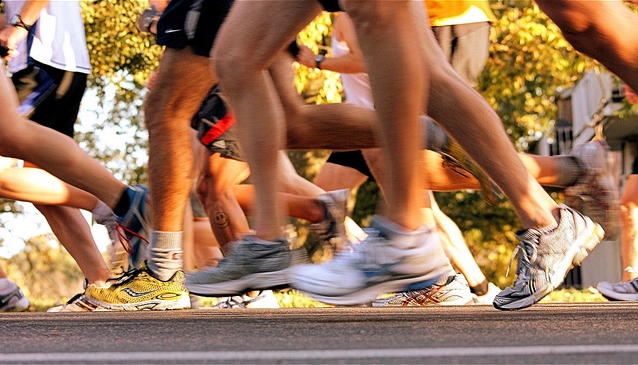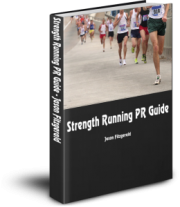I have a confession.
I’m not fair to all of my readers.

See, I provide a lot of free resources to those signed up to my private list, like:
- The How to Stay Fit on Vacation digital book
- A comprehensive master shopping list (so you never guess what to buy at the grocery store)
- Dynamic warm-up illustrations so you understand how to do each exercise
- Two exclusive, detailed articles on strength exercises and how to design better training
- The Strength Running PR Guide – a Q&A ebook that answers all your questions about running
Within a day of signing up, they’re automatically granted access to the secret page where they can download these resources – free of course.
Today, I want to provide a glimpse into The Strength Running PR Guide. I polled thousands of runners, asking them what questions they had about running.
Below are some of their questions and my answers.
1. The Pose Method and ChiRunning recommend a fairly fast leg turnover or cadence and to shorten your stride length to do it. What’s the best stride rate and length?
There’s no “magic” stride rate, although many people have recommended 180 steps per minute (including me). A fastER stride cadence than what you’re currently doing will likely help you prevent injuries and become a more efficient runner. If your cadence is a common 160 steps per minute or less, you should definitely try to increase your cadence by 5-10%. Keep in mind that if you’re running very slow, your stride rate will probably be lower than when you’re doing a track workout or racing. That’s ok.
Another issue that’s important that you mentioned is stride length. To get to a faster stride rate, you don’t want to artificially chop your stride so short that you’re running in a very unnatural way. What you want to do is put your foot down underneath your center of mass. You won’t land directly underneath your body, but it’s a good cue for yourself. When you start over-striding and “reaching out” with your lead leg, then your cadence will be much lower than it should be.
Another strategy is to never let your foot reach out further than your knee – if this happens, then you may be aggressively heel-striking and you’re probably landing very far out from your center of mass. When you do this you’re wasting energy, slowing yourself down, and increasing your injury risk.
2. How do you plan a training program for your runners and how do you change the running program following a injury or set back?
For my runners in the Full Coaching program, I have them fill out a detailed questionnaire so I know as much as possible about their past running history. I ask about mileage, workouts, race PR’s, goals that they have, injury patterns, even what surface they typically train on. I also ask about the last several weeks of their running so the plan I write won’t come out of nowhere -any good coach will progress intelligently.
The training program has a few components: a weekly template of mileage, workouts, and other exercises. I call it a template because I actually don’t like training schedules. Flexibility is important and life often gets in the way – and that’s ok! My runners know that one run won’t make or break their training, so we just move on and keep training.
Regarding setbacks, I’ve been lucky in that the vast majority of my runners have never had a serious injury. There have been small issues that require reduced training or taking several days of rest or cross-training. When there is a setback like this, the progression of training stops. When they can run pain-free again, then we repeat the last full week of training. If there is a harder workout planned I may reduce the volume/intensity of that workout to be safe, but it’s very personalized.
I’m often in daily communication with my runners and I get updates on how their training is going so I can adjust the plan on the fly. I’m thankful that my runners are healthy and training well.
3. How did you know you had recovered from your IT band injury if you weren’t training for 6 months?
Good question! My ITB injury was so severe that it was often painful while walking. So even though I wasn’t running, I could still feel that there was something very wrong with my left leg. After about two months of trying to jog slowly for 30 seconds and failing every 4-5 days, I just quit. I went through a period where I almost gave up hope on ever running again. I sat on my couch and ate a lot of Oreos. And ice cream. Often Oreos in ice cream. Clearly, I was a wreck.
When I stopped feeling sorry for myself, I got proactive. I bit the bullet and paid for a lot of physical therapy. My first three physical therapists had no idea what they were doing but my fourth was really good. He had me doing a lot of exercises that are in my ITB Rehab Routine. I also started doing a lot of research on what causes ITBS (very often it’s weak glutes and hips) so I added several exercises to the routine and started doing it three times every week in addition to PT.
After about a month, I got the green light to run. This decision was based on a diagnosis of my mobility, pain threshold during massage, and the level of scar tissue that was broken up by massage. I went for a 15 minute run and probably covered about 1.5 miles. I was horribly out of shape after having not run for six months, but there was no pain. I was ecstatic, but it took me about a year to get back into the shape I was in before.
4. I know I can improve a little with training, but at what point do I just accept that I’ve gotten as fast as I’m going to get?
Runners should always be hungry to run faster (if that’s your goal). Even if you have just run a big personal record, the next step is to evaluate your training and race execution and see where you can improve. World records have been set by men in their mid-30’s, long past when “experts” think runners reach their physiological peak. 
If you’ve been running competitively since high school, there’s a better chance that you will know when you have reached your peak. Despite the same or better training, your race performances will start to decline.
But for those runners who started later in life, it’s difficult to pinpoint when you’ve reached your best performances. My recommendation is to never settle and always stay hungry for better training, smarter workouts, and flawless race execution. Don’t be fooled – there’s always room for improvement. And you won’t improve a little with training – you will improve by leaps and bounds.
* * *
To get free access to all 37 questions and answers in The Strength Running PR Guide, just sign up here or in the box below. You’ll get your secret link automatically.